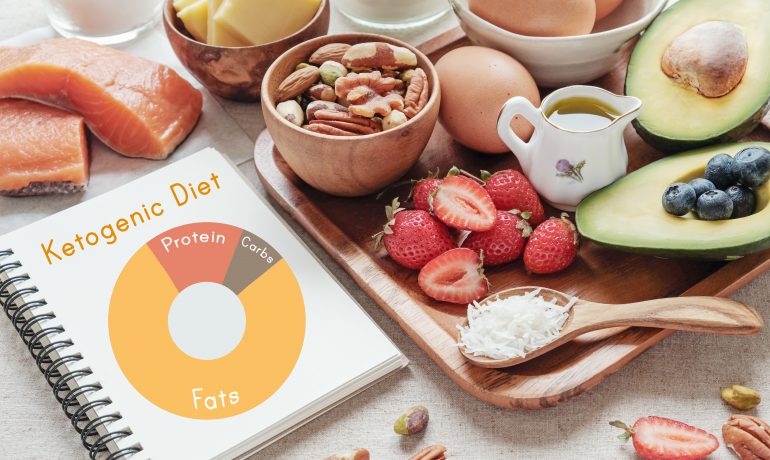The Keto diet (also known as a Ketogenic diet) is a low-carb, restrictive diet that burns a lot of fat in a shorter amount of time than most other diets. The idea behind the diet is to limit the intake of carbohydrates so that the body burns fat instead of glucose for energy. Is that all there is to the diet? Alot of people still ask the question “what is keto diet?”. We will explore other aspects.
The name of the diet comes from the way the process that the body goes through while on the diet–because there is no glucose for the body to burn as fuel, the body goes into a state of Ketosis, which is where the liver produces ketones from the breakdown of fats in the liver.
Ketosis is a metabolic state in which the body goes into a sort of “survival mode” when food is scarce. The idea behind the Keto diet is not to starve yourself, but to activate this metabolic state by limiting your intake of carbohydrates. Carbohydrates are usually the first thing your body burns for energy, but without carbohydrates your body will turn to the next best option which is fat.
The Keto diet, surprisingly, was not first developed as a means of weight loss. It started as a treatment for epilepsy patients in the early 1900s. Fasting had long been used to treat health conditions, but the actual process of ketosis was discovered by Rollin Woodyatt in 1921 and in that same year, Russel Wilder coined the term “Ketogenic Diet”. It was still used for epilepsy treatment at that time and didn’t become popularly recognized as a weight-loss diet until a few years ago.
What Are the Benefits of a Keto Diet
A Keto diet has a lot of health benefits. The most obvious two benefits are weight loss and relief from epilepsy symptoms (since this is what is was created for in the first place), but there are many other benefits as well. Some of the other health benefits include:
- Improved mental focus.
- Controlled blood sugar.
- Improved triglyceride and cholesterol levels.
- Increased energy.
- Improvements in insulin resistance.
- Improvements with acne-related conditions.
The key to obtaining these health benefits is to follow the Keto diet as closely as possible and be consistent. Results may vary, as with all diets but the results of the Keto diet tend to be a little more regular than others.
What Can You Eat on a Keto Diet?
A Keto diet consists of a high amount of fats, a moderate amount of protein, and a low amount of carbohydrates. You must cut your carbohydrate intake down dramatically to get to a state of ketosis. The amount of carbs that need to be cut can vary from person to person, but in general it is suggested to eat less than 50 grams of carbs per day to achieve ketosis.
You must cut out all grains, sugars, fruit, and high-starch items such as potatoes. You also have to be aware of hidden carbohydrates in things like cough syrup, beverages, and even breath mints.
The key to a proper Keto diet is making sure to have a high amount of the right kind of fats and an average amount of protein. You must eat the right fats in order for the diet to be healthy. Saturated fats, monosaturated fats, and some polyunsaturated fats are good for a Keto diet.
Do not eat any trans fats at all. Here are a few foods that you can eat on a Keto diet and the type of fats they have:
Sources of saturated fats:
- Butter
- Coconut oil
- Pork
- Lamb
- Beef
- Cheese
Sources of monosaturated fats:
- Nuts
- Olive oil
- Seeds
- Eggs
- Some types of fish
- Some types of cheeses
Sources of polyunsaturated fats:
- Nuts
- Chicken
- Seeds
- Duck
- Some types of fish
- Quinoa
- Avocado
Signs That Your Body Has Entered Ketosis
The process of achieving ketosis can vary from person to person and there is no hard rule about how long it will take. There are a couple of obvious signs that your body gives that alerts you to when you have achieved this metabolic state, and the signs are usually pretty universal.
One unpleasant sign is bad breath. This happens because acetone is one of the ketones released in ketosis and is expelled through your breath.
Rapid weight loss is another sign. This happens because your body uses up all of your carbohydrate and water stores and there isn’t any more of it coming in to your body. After this, studies have shown that the body can burn up to 200% more fat during exercise than it could before going into ketosis.
Conclusion
The Keto diet is a diet that has many benefits including rapid weight-loss. The diet isn’t for the faint of heart. It is a very restrictive diet and can have some temporary side effects like fatigue, insomnia, and digestive problems.
It takes some time for the body to adjust to the diet. But once your body does, the side effects go away and the benefits will outweigh the discomfort of those effects. Finally, as with any diet, consult with your physician to make sure that you are healthy enough to sustain the Keto diet.


